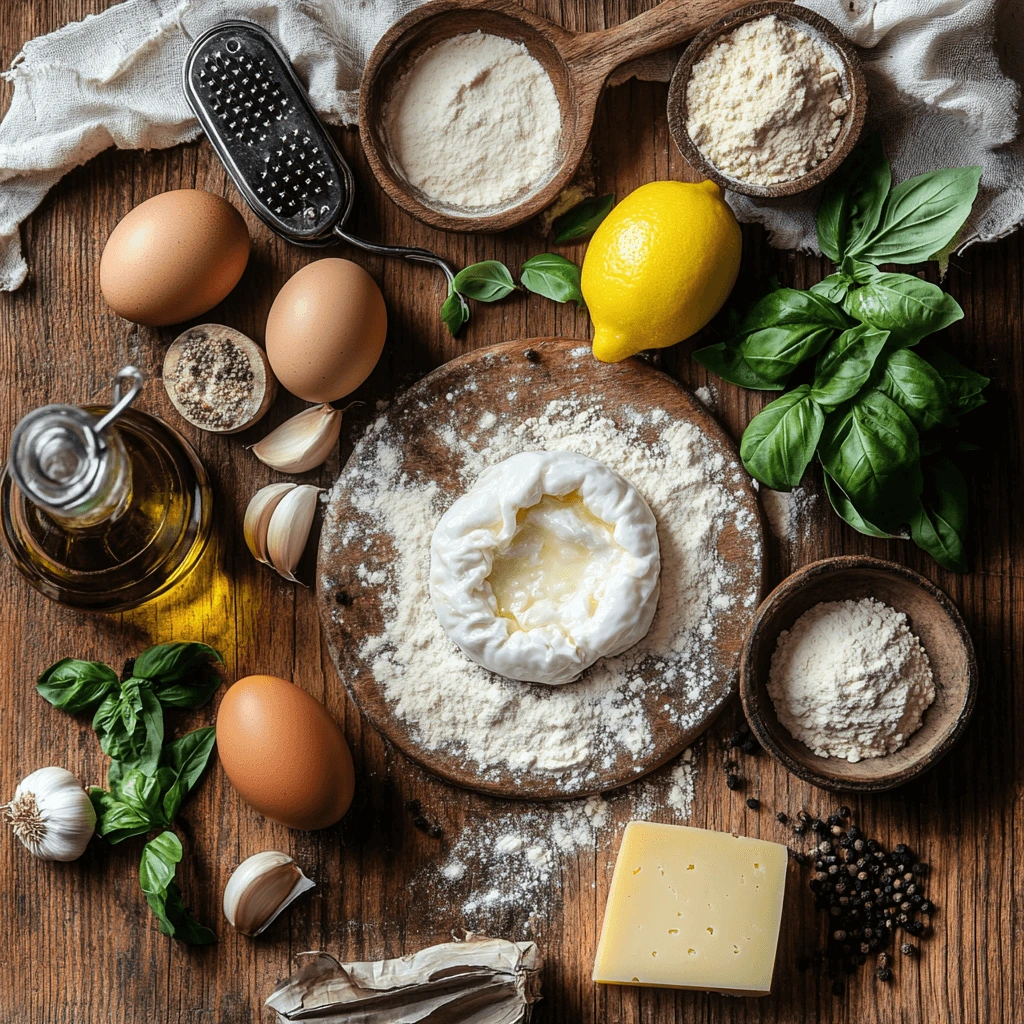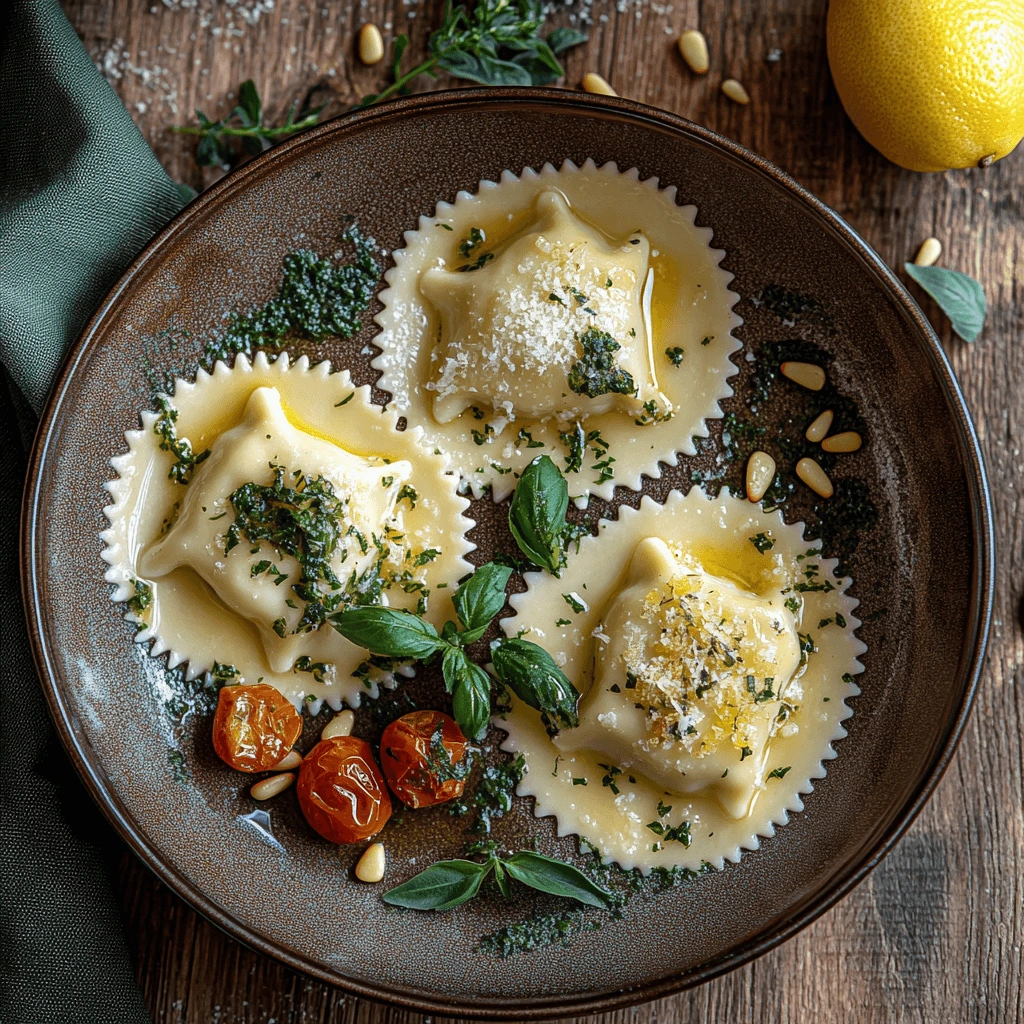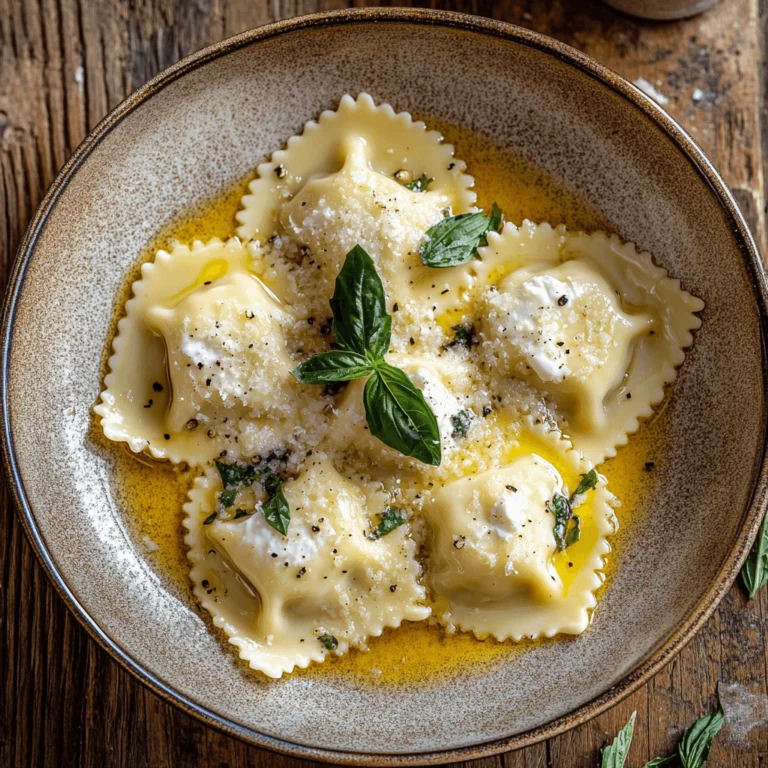When you think of Italian cuisine, chances are you imagine fresh herbs, quality olive oil, and pasta in all shapes and sizes. However, there is a special kind of pasta that stands out for its sumptuous texture and rich flavor: burrata ravioli. This dish has the power to captivate your taste buds with each and every bite. Indeed, the simple yet luxurious elements of burrata paired with homemade ravioli dough can instantly transform an ordinary dinner into a special, memorable occasion. In this post, we will explore how to create this masterpiece from scratch, discover which ingredients you truly need, and learn a bit of history along the way. Above all, we will ensure that by the end of this guide, you have a foolproof method for preparing a romantic meal that everyone will adore.
What Makes Burrata Ravioli So Special?
It is easy to assume that burrata ravioli is just another stuffed pasta dish. Nonetheless, there is something undeniably magical about the combination of burrata’s luscious, creamy interior enclosed within delicate, homemade ravioli dough. Before we dive into the nitty-gritty details of ingredients and cooking methods, it is helpful to understand precisely why burrata ravioli has become a go-to for food lovers worldwide.
The Magic of Burrata Cheese
Burrata, which hails from the southern region of Italy known as Puglia, is a special type of cheese that evolved from mozzarella-making traditions. While mozzarella is cherished worldwide for its pleasantly mild flavor and slightly elastic texture, burrata takes creaminess a step further. In fact, burrata features a shell of mozzarella on the outside and a creamy filling called stracciatella on the inside. Consequently, each cut into burrata releases a luxurious, milky interior that tastes subtly sweet and rich.
Because it is often produced in smaller artisanal batches, burrata has a melt-in-your-mouth consistency. This texture makes it a phenomenal filling for ravioli. Moreover, when you stuff burrata into fresh pasta pockets, every forkful bursts with smooth cheese and gentle milky undertones. Thus, even though there are many varieties of stuffed pasta throughout Italy, burrata ravioli remains unique for its indulgent center.
Different from the Usual Ricotta Filling
Traditional ravioli recipes typically involve ricotta mixed with spinach, mushrooms, or even various cheeses. Yet burrata provides an elevated twist. While ricotta can be slightly grainy or fluffy, burrata offers a velvety softness that envelops your tongue. Therefore, if you love the creamy sensation of ricotta but wish it had a silkier bite, burrata is the perfect answer. Furthermore, burrata often has a delicate sweetness and freshness that stands out immediately.
A Romantic Twist on Italian Pasta
Thanks to burrata’s special allure, burrata ravioli is an excellent choice for date nights or anniversary celebrations. Undeniably, the dish feels extravagant enough for special occasions. Nonetheless, with the right instructions, you can still prepare it in a normal home kitchen. Italians have long cherished handmade pasta as a labor of love. As a result, homemade burrata ravioli continues that tradition by allowing you to handcraft each piece with careful attention.
A Brief Historical Glimpse
Ravioli itself dates back many centuries, although historians debate its exact origin. Some say it was first mentioned in 14th-century Venetian documents. Others argue that stuffed pastas were widespread even earlier in Roman times. On the other hand, burrata is a more modern invention, created during the early 20th century when dairy farmers in Puglia experimented with leftover mozzarella pieces. Consequently, the combination of burrata and ravioli is a relatively new phenomenon—one that captures the best of old-world craftsmanship and modern innovation. Moreover, as time goes on, more food enthusiasts continue to discover burrata ravioli and fall head over heels for its luxurious charm.
To explore more about its origins and flavor profile, check out this detailed guide on burrata cheese.
Ingredients You’ll Need for the Perfect Burrata Ravioli

Knowing what goes into your dish is vital for both taste and texture. Furthermore, gathering high-quality ingredients ensures each bite of burrata ravioli is worth savoring. Below, we break down the essential components, along with helpful insights for picking the freshest options.
Fresh Pasta Dough Essentials
- All-Purpose Flour and/or Semolina Flour
The pasta dough typically requires a blend of flours, although you can use all-purpose flour on its own. Semolina adds a bit of firmness and traditional yellow hue. If you decide to blend them, for instance, you might choose 50% all-purpose and 50% semolina. - Eggs
Eggs are a cornerstone of homemade pasta. Generally, you use around one egg per 100 grams of flour, though this can vary depending on personal preference. The yolk’s richness contributes to the pasta’s flavor, and the whites lend structure. Because we aim for a luxurious dough that complements burrata’s creaminess, using fresh, high-quality eggs is recommended. - A Splash of Olive Oil
Although some pasta recipes skip olive oil altogether, a spoonful of extra-virgin olive oil can enhance flexibility. It also imparts a subtle richness, which seamlessly marries with the burrata filling’s silky consistency. - Pinch of Salt
A dash of salt is crucial. Not only does it boost flavor, but it also helps condition the dough. In addition, it prevents the final product from tasting bland.
How to Make the Perfect Filling for Burrata Ravioli
- Burrata Cheese
Obviously, burrata is the star here. When you purchase it, check the expiration date and try to choose a product that is as fresh as possible. Also, keep it chilled until you are ready to use it, because burrata can degrade quickly if left out too long. - Freshly Grated Parmesan
While burrata alone has a soft sweetness, adding parmesan gives a nuanced savory balance. Select high-quality Parmigiano Reggiano if available, as it brings depth and a salty note that complements burrata’s creaminess. - Zest of Lemon (Optional)
A hint of lemon zest can brighten the cheese filling, making each bite more refreshing. Moreover, it pairs brilliantly with the sweet-salty nature of burrata. - Seasonings
Ground black pepper, a sprinkle of salt, and even a dash of nutmeg can round out the flavor profile. However, use them sparingly to avoid overshadowing the burrata.
Ideal Sauces and Additional Garnishes
Although we will discuss sauces in more detail later, it is helpful to gather everything ahead of time. Some of the best sauce components for burrata ravioli include fresh basil, garlic, butter, or even slow-roasted tomatoes. Furthermore, you might want toppings like toasted pine nuts, crispy shallots, or a drizzle of high-quality olive oil for garnishing.
Sides and Serving Complements
While burrata ravioli can stand on its own as a main course, you might wish to pair it with a light salad. Arugula, spinach, or baby kale tossed in a tangy vinaigrette can provide a refreshing contrast. Additionally, crispy breadsticks or a loaf of artisanal bread can help sop up any leftover sauce.
Step-by-Step: How to Make Burrata Ravioli at Home
Crafting your own burrata ravioli can seem intimidating at first. Nevertheless, following a methodical approach will make it not only achievable, but also fun. Below is a comprehensive guide covering everything from dough preparation to the final boil.
1. Preparing the Pasta Dough
- Measure and Mix
Start by measuring out about 200 grams of flour (with an optional blend of semolina) for every two large eggs. Though this ratio is flexible, it generally yields a smooth, pliable dough. Then, create a well in the center of the flour on a clean surface. Carefully crack your eggs into the center, and add a small drizzle of olive oil plus a pinch of salt. - Combine and Knead
Use a fork to beat the eggs gently, gradually incorporating the surrounding flour. Once a sticky dough begins to form, you can switch to using your hands. Knead the dough for at least 5–8 minutes. This process develops gluten strands, giving the pasta a slight chewiness. Consequently, you will notice the dough transition from rough and shaggy to soft and elastic. - Rest the Dough
Wrap the ball of dough in plastic wrap, or place it under an inverted bowl, and let it rest for 30 minutes at room temperature. Resting is crucial because it allows the gluten to relax, making the dough easier to roll out.
2. Preparing the Burrata Filling
- Drain Excess Liquid
Open the burrata package carefully over the sink, removing as much excess liquid as possible. Next, gently transfer the cheese to a mixing bowl. If you have large lumps, break them up with a fork. - Incorporate Parmesan and Seasonings
Grate about 1/4 cup of parmesan (or more if you love an intensely cheesy flavor) and combine it with the burrata. Add a small pinch of salt, a little pepper, and a touch of lemon zest if you prefer a brighter flavor. Remember not to go overboard with seasonings, since burrata can be delicate. Stir everything together until it forms a creamy mixture. - Optional Thickeners
Because burrata can be quite watery, you might mix in a small spoonful of fresh ricotta or even some finely grated parmesan to achieve a thicker texture. This step ensures your filling is easier to handle when placing it onto the dough circles.
3. Rolling and Cutting the Dough
- Roll Out the Dough
After resting, divide the dough into two or three smaller pieces. Dust your work surface with flour, and roll each piece with a rolling pin or a pasta roller. Roll until the dough is roughly 1-2 millimeters thick. For reference, you should be able to see your hand through the dough when you lift it to the light. - Cut the Ravioli Shapes
Use a round cookie cutter or a ravioli stamp to cut circles or squares, depending on your preference. Alternatively, some cooks create long sheets, then place dollops of filling at intervals, folding the sheet over and cutting around the filling with a fluted pasta wheel.
4. Assembling and Sealing the Ravioli
- Place the Filling
Spoon about a teaspoon of the burrata mixture into the center of each dough piece. Avoid overfilling, as you need space for sealing the edges. - Seal It Tight
If you are making circle-shaped ravioli, brush a tiny bit of water around the perimeter of one dough circle. Gently place another piece of dough on top. Press the edges together, ensuring you remove any air pockets around the filling. Trapped air can cause the ravioli to burst open during boiling. If you are making half-moon shapes, simply fold one piece of dough over the filling and seal. - Keep Ravioli Fresh
Place the sealed ravioli on a tray dusted with semolina or flour to prevent sticking. Cover them lightly with a clean kitchen towel while you finish the remaining dough.
5. Cooking the Ravioli
- Boil a Large Pot of Water
Add a generous pinch of salt. When the water reaches a rolling boil, drop in a few ravioli at a time, being careful not to overcrowd the pot. Consequently, they will cook more evenly. - Watch for Floating
Burrata ravioli typically cooks within 2–4 minutes. They will float to the surface when they are close to done. Taste one if you are unsure. The dough should be al dente and the burrata warm and creamy inside. - Drain Gently
Use a slotted spoon or spider strainer to remove the ravioli from the water, letting any excess water drip off. Immediately transfer them to a warmed serving bowl or pan with sauce to avoid sticking.
If you love making filled pasta, don’t miss our Short Rib Ravioli recipe — rich, comforting, and packed with flavor.
Best Sauces and Serving Ideas for Burrata Ravioli

Burrata ravioli is undeniably delicious on its own, yet the right sauce or garnish can heighten the experience even more. Although you can experiment with countless flavor profiles, here are a few popular—and delectable—ways to serve your homemade masterpiece.
Creamy Basil Sauce
If you adore a velvety texture, then a basil cream sauce pairs perfectly with burrata ravioli. To make it, sauté minced garlic in a little butter or olive oil. Then, add heavy cream and let it reduce slightly. Next, stir in finely chopped fresh basil and grated parmesan to taste. Finally, simmer until it thickens enough to coat the back of a spoon. This bright, herb-forward sauce complements burrata’s softness while maintaining a subtle, refreshing punch.
Roasted Cherry Tomato Sauce for Burrata Ravioli
For a burst of flavor that does not overpower, roast cherry tomatoes in the oven with olive oil, garlic cloves, salt, and black pepper until they blister. During roasting, the tomatoes release their natural juices, creating a simple yet robust sauce. You can toss the cooked ravioli in these roasted tomatoes, letting their sweetness underscore the creamy filling. Additionally, you may sprinkle a bit of fresh parsley or basil on top.
Lemon Brown Butter
Butter sauces often excel at bringing out the best in cheese-filled pasta. To prepare lemon brown butter, melt unsalted butter in a pan. Allow it to foam and eventually turn golden-brown, releasing a fragrant, nutty aroma. Immediately reduce the heat, then stir in a small amount of lemon juice or zest. Stir well and toss the ravioli in this sauce briefly. The bright acidity from the lemon balances the butter’s richness—and also accentuates burrata’s milky taste.
Garnish and Plating your Burrata Ravioli
- Fresh Herbs and Microgreens
A sprinkle of finely chopped basil, parsley, or microgreens can add a dash of color and a hint of freshness. - Crunchy Toppings
Some cooks enjoy adding toasted pine nuts, crushed walnuts, or even crispy shallots to provide a textural contrast to the soft burrata filling. - Final Touch
Finish with a drizzle of extra-virgin olive oil or a shaving of parmesan. Not only does this seal in additional flavor, but it also makes the dish look elegant and restaurant-worthy.
Burrata Ravioli FAQ: Tips, Variations, and Common Questions
Whenever we discuss burrata ravioli, a few questions inevitably arise. Therefore, it is helpful to address these queries in one place. Below, we tackle the most common concerns regarding this delightful dish.
Can I Freeze Burrata Ravioli?
Yes, you can freeze uncooked burrata ravioli successfully. First, arrange the freshly assembled ravioli on a parchment-lined tray, making sure they do not touch one another. Next, place the tray in the freezer until the pasta is firm, roughly an hour. Afterward, transfer them into a freezer-safe container or bag. This method prevents them from sticking together. When you are ready to cook, you can drop the frozen ravioli straight into boiling water. However, you might need to add an extra minute or two to the cooking time.
What If I Can’t Find Burrata Cheese?
In some areas, burrata might be hard to locate. As a substitute, you can combine fresh mozzarella with a little cream or stracciatella cheese if available. Another option is a mixture of ricotta and shredded mozzarella for a somewhat similar outcome. Although you will not get the exact same luxurious texture as real burrata, these alternatives can still deliver a creamy filling. Moreover, you can experiment with different cheeses for unique flavors.
Is This Recipe Vegetarian?
Yes, the base recipe is vegetarian, as it uses only cheese, eggs, and flour. Make sure your parmesan or other hard cheese is vegetarian-approved (some brands are not). In addition, avoid using any sauce that includes animal-based broth. Instead, opt for vegetable or herb-based sauces.
How Do I Store Leftovers?
If you have leftover burrata ravioli that is already cooked, you can store them in an airtight container in the refrigerator for up to two days. When reheating, do so gently. You can place them in a pan with a splash of water or sauce, covering the pan, and warm over low heat. Reheating them quickly or at high heat could lead to a rubbery pasta texture.
Any Variations to Try?
- Spinach-Infused Pasta
For a colorful twist, blend cooked spinach into the dough, adding a green hue and extra nutrients. - Spicy Kick
If you enjoy bold flavors, add a pinch of red chili flakes to the sauce or filling. This subtle heat can contrast beautifully with the burrata’s creaminess. - Truffle-Infused
Drizzle a bit of truffle oil into your sauce, or garnish with shaved truffles for an ultra-gourmet finish. - Light Tomato Sauce
A simple marinara made with fresh tomatoes and herbs can offer a more traditional Italian flair, complementing the burrata’s milky sweetness.
Conclusion
By now, you have learned how to craft burrata ravioli that will dazzle both you and your dinner guests. In truth, making homemade pasta might seem like a laborious process at first. Nevertheless, once you see (and taste) the results of your effort, you will understand why Italian cuisine holds such a global appeal. From kneading the dough to stuffing each ravioli with velvety burrata, every step invites you to discover a deeper connection with food and tradition. Moreover, this recipe has a certain adaptability, allowing you to add personal touches—whether through herbs, spices, or sauces—that elevate the entire experience.
Above all, do not forget that good food also carries history with it. Burrata itself was born out of resourcefulness in Puglia, and ravioli has roots that stretch back many centuries. Therefore, when you bring these two together in one dish, you effectively celebrate both the ingenuity of cheesemakers and the heritage of Italian pasta. Additionally, you create a meal that can easily transform an ordinary evening into something extraordinary.
So go ahead: gather your ingredients, clear a spot on your countertop for rolling dough, and prepare to wow your senses. Whether you share it with someone special or indulge on your own, you will find it hard not to “fall in love with every bite.” And, most importantly, the next time you crave something truly special, you will know exactly how to recreate the magic of burrata ravioli in your own kitchen.
Planning a full homemade Italian meal? Try our Braided Chocolate Chip Brioche for a sweet, satisfying finish.

